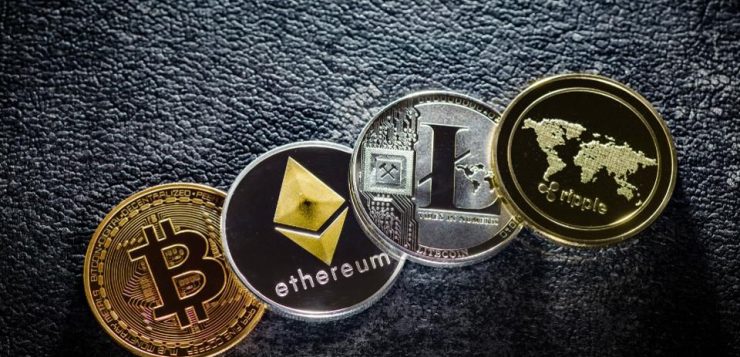Every one is unique, but they have one thing in common: investors think they’re worth billions.
Bitcoin (BTC)
Launched: 2009 Market value: $163 billion
The strengths: The original cryptocurrency, Bitcoin is the largest and most popular blockchain network—and the most battle-tested against attackers.
The downside: Growing demand has stressed Bitcoin’s network, making transactions expensive. The system, which can process only about seven transactions per second, nonetheless guzzles electricity owing to its consensus protocol, proof of work, designed to make mining labor-intensive.
Ethereum (ETH)
Launched: 2015
Market value: $70 billion
The strengths: A built-in programming language lets developers write computer programs, called smart contracts, that run on the blockchain. Most initial coin offerings (ICOs) so far have been based on Ethereum smart contracts.
The downside: Ethereum also uses proof of work, making it relatively slow and energy-hungry. Many early smart contracts are vulnerable to hacking, and the field of smart-contract security is immature.
Ripple (XRP)
Launched: 2017
The strengths: Ripple says its crypto-token, called XRP, can be a “bridge currency” that financial institutions use to settle cross-border payments faster and more cheaply than they do now. It uses a novel consensus protocol that allows for much faster transactions than Bitcoin and Ethereum.
Launched 2012 Market value: $32 billion
The downside: Since Ripple, a privately owned company, has so much control over the system, purists say XRP isn’t decentralized enough—in contrast with Bitcoin, which anybody can mine.
Bitcoin cash (BCH)
Launched: 2017
Market value: $19 billion
The strengths: The creators of this currency, the product of a “hard fork” of Bitcoin, tweaked Bitcoin’s software to handle larger transaction volumes.
The downside: Critics say Bitcoin Cash is too centralized—a handful of miners create most of the coins.
Litecoin (LTC)
Launched: 2011
Market value: $10 billion
The strengths: Litecoin is an “alt-coin”—nearly a clone of Bitcoin, but with a few alterations. It processes transactions four times faster, and its mining process is designed to remain open to hobbyists—not the case with Bitcoin, in which professional miners use expensive hardware.
The downside: Though faster than Bitcoin, Litecoin is still too slow and energy-hungry to be an ideal payment method, and it has the added handicap of being far less well-known.
Cardano (ADA)
Launched: 2017
Market value: $5.9 billion
The strengths: Cardano’s creators say the system, which is still only a platform for trading and transferring its token, puts an emphasis on privacy and regulatory compliance. They also say it will eventually host smart contracts. In that way it will be like Ethereum—but it uses a proof-of-stake consensus protocol and thus gobbles up less energy.
The downside: Despite big claims from the developers, there’s still very little information on Cardano.
Neo (NEO)
Launched: 2014
Market value: $5.8 billion
The strengths: China’s biggest cryptocurrency, NEO is a smart-contract platform with goals similar to Ethereum’s. It uses a consensus protocol called delegated Byzantine fault tolerance, which NEO’s creators say allows for 10,000 transactions per second, compared with Ethereum’s 15.
The downside: NEO is highly centralized, and it’s not clear that this will ever change. The founder has said that the plan is to make it more decentralized “someday.”
Stellar Lumens (XLM)
Launched: 2014
Market value: $5.6 billion
The strengths: Stellar, whose ledger is a hard fork of Ripple’s, likewise aims for its lumens to be a bridge currency for cross-border payments—only it’s run by a nonprofit, instead of a for-profit company. It also plans to compete with Ethereum as a platform for initial coin offerings.
The downside: Stellar faces a lot of competition, from both Ripple and the traditional banking system’s dominant platform, SWIFT, which is testing distributed-ledger technology with blockchain-ish elements.
Eos (EOS)
Launched: 2017
Market value: $4.3 billion
The strengths: EOS tokens exist and are currently traded on Ethereum, though the smart-contract platform itself, billed as yet another Ethereum killer, has yet to launch. Like Cardano, it will use a proof-of-stake protocol instead of proof of work, theoretically making transactions faster and more efficient.
The downside: Despite being on track to raise more than $1 billion via an ICO, the project is nearly impossible to judge before the network has launched.
Monero (XMR)
Launched: 2014
Market value: $4.3 billion
The strengths: Monero uses ring signatures, a type of digital signature that lets any member of a group perform a transaction without revealing which one of them it was. It’s a way to let users transact privately, and its mining process is designed to be “egalitarian.”
The downside: Monero’s features have made it a preferred coin among cybercriminals, and it has helped fuel the rise of “cryptojacking,” in which hackers use malware to make other people’s computers mine cryptocurrency for them.
Dash (DASH)
Launched: 2014 (formerly XCoin and Darkcoin)
Market value: $4.3 billion
The strengths: Another so-called privacy coin like Monero, Dash is inspired by Bitcoin but has features that speed up payment processing.
The downside: Like some others, Dash has a centralization problem. Because of a mishap, too many coins were distributed when it was first released, concentrating the wealth and giving a small group disproportionate power in decisions over the currency’s future.
Iota (MIOTA)
Market value: 3.8 billion
The strengths: IOTA’s system does not use a blockchain, instead employing a shared ledger based on a mathematical structure called a directed acyclic graph. It aims to be a currency used by internet-of-things devices to buy, sell, and trade data, whether the transaction partners are other devices or customers like technology companies.
The downside: Critics say IOTA is too centralized, and numerous cryptography researchers have questioned the system’s overall security.
Read more at: Technology Review







